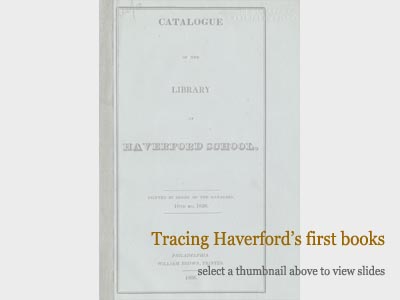Evidence from the catalog


 Loading image. Please wait
Loading image. Please wait
Additional Resources
- The Library in 1833
basic facts about Haverford's first library - Library Catalog, 1836
Before opening their school, Haverford's Board of Managers appointed a committee to purchase books for the school library. This committee's careful selections of current and classical authors were designed to raise the school’s prestige and to indicate the rigorous study that Haverford's “guarded and liberal” education would require. In particular, the inclusion of “complete sets of the Latin and Greek Classics” made clear that unlike many Quakers, the Board of Managers believed that an exposure to great works by non-Christians was essential to the intellectual development of young boys. Their library also included key mathematical and scientific treatises in the original French and versions of Barclay’s Apology, a key Quaker text, in English, Latin, Danish, and Spanish. Unsurprisingly, books by and about Quakers were well represented, including works by Quaker women as well as men.
Haverford's first catalog is just as notable for what it did not include. The selection of English literature was small: lumped together into a catch-all section of the catalog titled “Works of Authors who have Written on Various Subjects,” one may find Addison, Johnson, Bacon, Milton, and Pope, but almost nothing that could be mistaken as unwholesome or frivolous. There is no Donne, Pepys, Defoe, or Swift, and certainly no Shakespeare. Over the course of ensuing decades, however, the activities of Haverford student societies and other community members would significantly change the makeup of the collection.






